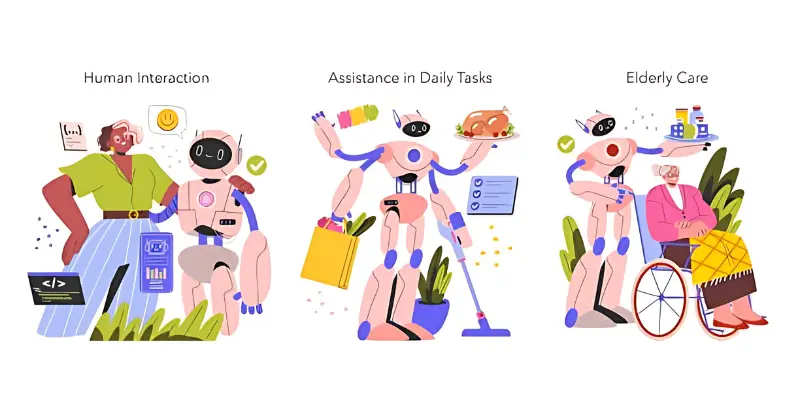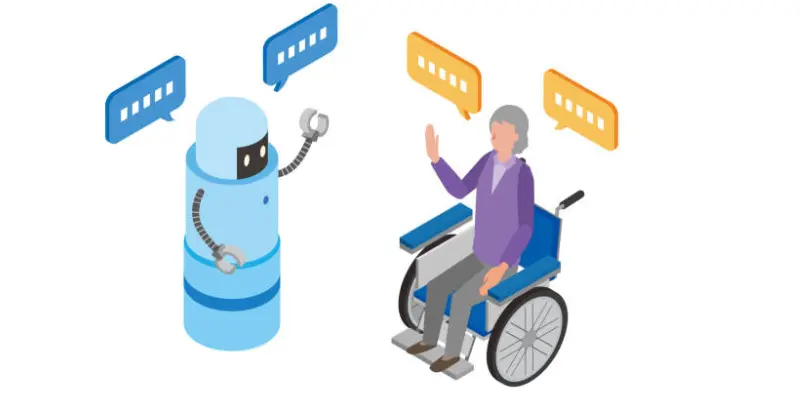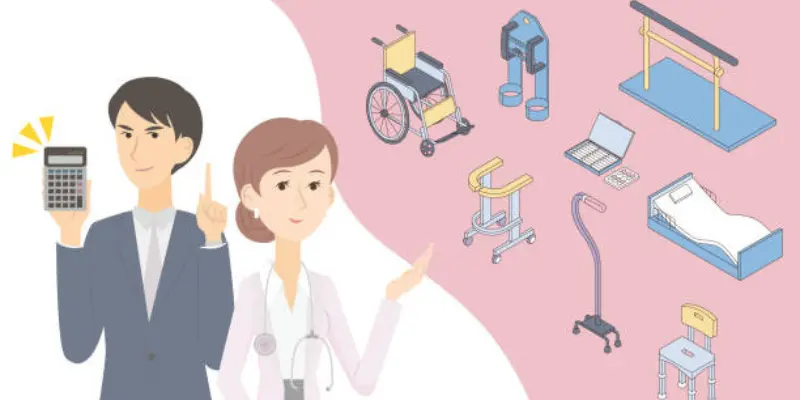AI Caregivers in Healthcare: Leading to Better and More Personal Care
Published: 5 May 2025
Did you know the world’s population over 65 is expected to double by 2050? As people live longer, the demand for support at home is rising fast. That’s where the AI caregiver steps in. It’s not just a robot or an app, it’s a smart tool that helps in monitoring, reminding and caring for people who need daily support, especially the elderly or those with health conditions.
But the question is, Is an AI caregiver a real person or just a machine? Many people hear the term and imagine robots taking over homes. But in truth, AI caregivers are smart assistants that support real caregivers and not replace them. Caring for a loved one at home can be stressful, especially when you can’t be there all the time. Missed medications, wandering or falls can create constant worry. That’s why many families are turning to the AI caregiver.

I am here with a new blog post on this very important topic and going to cover each and every aspect of AI caregivers. Let’s start
What Is an AI Caregiver?
Imagine a helpful friend who never sleeps, always watches over your loved one and gently reminds them to take medicine or drink water. That’s what an AI caregiver is like and it’s not a person. It’s a smart system powered by artificial intelligence that cares for people, especially the elderly, sick or those with disabilities.
Technically, an AI caregiver is a tool or device that uses AI to support daily care tasks. It can remind patients to take medicine, track their health, detect falls or even alert family members if something seems wrong. Some come as apps, smart speakers or even robots, all designed to make caregiving safer and easier.
Importance of AI Caregiver for Elders
Growing older often means needing more help with daily tasks. But not everyone has someone around 24/7. That’s where an AI caregiver becomes important. It acts like a smart helper that reminds you to take your medicine, checks if you have eaten and even alerts someone if you fall. For elders who live alone or want more independence, this kind of support brings comfort, safety and peace of mind—without giving up freedom.
Importance of AI Caregiver for Healthcare Professionals
Doctors, nurses and caregivers are under pressure. Too many patients. Not enough hands. The AI caregiver steps in to fill that gap. It helps to monitor patients remotely, send alerts when something is wrong and manage daily routines like reminders and medication schedules. For professionals, this means better care, fewer errors and more time to focus on tasks that need a human touch. It’s not here to replace them but it’s here to support them.
Importance of AI Caregiver for Parents
Busy parents often worry about their aging parents at home. They can’t always be there, and that’s tough. An AI caregiver offers a helping hand. It keeps an eye on mom or dad, reminds them of their medicine and can even message you if something seems off. With this smart support, parents can focus on their kids and work, knowing that their loved ones are cared for too.
Also read: Top AI Caregiver Tools in this year
How Does an AI Caregiver Actually Work?
An AI caregiver works like a smart assistant that watches, listens and responds to a person’s needs. It’s built using a few key components: sensors, AI software and communication tools. Sensors help the system to track movement, detect falls or check daily routines like eating or sleeping. The AI software processes this data, learns patterns and makes smart decisions like sending reminders or alerting family if something goes wrong.
The caregiver connects to phones, smart devices or sometimes even robots. For example, if someone forgets to take their medicine, the system can send a gentle voice reminder. If it detects no movement for hours, it can notify a caregiver. Over time, the AI learns habits and adjusts. It doesn’t just follow fixed rules it also adapts to the person’s daily life to offer better care, day by day.

Step-By-Step Process
Here’s how an AI caregiver usually works, in a step by step fashion:
- Step 1: Sensing the Environment
It uses motion sensors, cameras or health trackers to observe what’s happening in real-time. - Step 2: Collecting Data
It gathers details like movement, medicine times, eating habits or sleep patterns. - Step 3: Analyzing Behavior
The AI studies this data to understand normal routines and spot anything unusual. - Step 4: Taking Action
Based on what it learns, it sends reminders, speaks up or even calls for help when needed. - Step 5: Updating and Learning
Over time, it improves by learning the person’s habits and making smarter decisions.
Also Read: AI Stethoscope in Healthcare
Types of AI Caregivers (And Who Should Use Them)
Not all AI caregivers are the same. Some are smart devices, others are apps and a few even look like friendly robots. Here are the main types:
1. Voice-Based AI Caregivers
These are smart speakers or voice assistants like Alexa or Google Nest set up with care-focused features.
Best For:
Elders who can speak clearly and want reminders, health tips or help without pressing buttons.
🟢 Good for seniors with mild memory issues who live alone.
2. Sensor-Based Monitoring Systems
This type uses motion sensors and cameras to track movement, sleep or safety risks.
Best For:
Busy families or working professionals who want to keep an eye on elderly parents remotely.
🟢 Great for elders who may forget things or have a history of falls.
3. Wearable AI Devices
These AI wearables are smartwatches or health bands that track heart rate, movement or location. Some send alerts during falls or health issues.
Best For:
Active seniors or people with medical conditions who move around a lot.
🟢 Ideal for stroke survivors, heart patients or people at risk of falls.
4. AI-Powered Chatbots or Apps
These are phone or tablet apps that talk, ask questions and remind users to take medicine or do daily tasks.
Best For:
Tech-savvy elders or caregivers who want digital support and communication.
🟢 Useful for adults managing care from far away or elders who enjoy screens.
5. Robotic AI Caregivers
These are robots with AI features that can talk, move and even help with simple physical tasks like fetching objects.
Best For:
Elders with limited mobility or who feel lonely.
🟢 Good for long-term home care or assisted living environments.
✅ Summary: Which One Fits Best?
| User Type | Best AI Caregiver Type |
| Independent Elder | Voice-based or wearable AI |
| Busy Working Children | Sensor-based or app-based AI |
| Tech-Savvy Seniors | Chatbot or app AI |
| High-Risk Patients | Wearable or robotic AI |
| Lonely Seniors | Robotic AI with social features |
Advantages and Disadvantages of AI Caregiver in Daily Life
AI caregivers are becoming a key part of daily routines, offering both convenience and support. However, like any technology, they have their strengths and limitations. From work to study sessions, AI caregivers can make life super simple but it’s important to understand how they can both help and hinder in various situations. As AI caregivers grow in popularity, it’s important to consider the benefits and drawbacks they bring to everyday activities like work, study and relaxation.

While Working (for professionals or remote workers)
✅ Advantages:
- Send alerts if your elderly parent needs help while you’re busy in meetings.
- Tracks routines and health without you constantly checking in.
- Helps you stay focused knowing someone is watching over your loved one.
❌ Disadvantages:
- Notifications can be distracting during deep work.
- Over-relying on it may reduce personal check-ins.
- Needs a strong internet connection to work smoothly.
Suggested Article: Risks of AI Associated with Diagnosing Diseases
While Studying (for students caring for family)
✅ Advantages:
- Reminds your elders to eat, rest or take medicine, so you can study in peace.
- Some AI apps even log reports, so you don’t miss anything important.
- Reduces guilt and worry during exams or classes.
❌ Disadvantages:
- May not respond well to fast-changing needs like sudden sickness.
- Setup may feel complicated for students with low tech skills.
- Dependence on tech could cause stress if the system fails.
During Entertainment or Relaxation Time
✅ Advantages:
- Lets you enjoy your games or outing while it watches over your loved one.
- Some AI systems work silently in the background without interrupting your fun.
- Reduces the emotional stress of “what if something happens?”
❌ Disadvantages:
- AI may send alerts that interrupt your free time, even for non-urgent issues.
- Not all devices understand when you are unavailable, so they may keep pinging.
- Over-monitoring can make family members feel “watched” too much.
Conclusion
In conclusion, AI caregivers have the potential to significantly improve daily life, offering both convenience and support. While there are some challenges to consider, the benefits they bring can truly make a difference in your routine. The future of caregiving is evolving and exploring AI caregivers further could lead you to a solution that will be both efficient and life-changing. Don’t hesitate to dive deeper and discover how this innovative technology can enhance the well-being of you and your loved ones.
More Queries?
Here are you frequently asked questions–answered in an easy way for better understanding:
AI caregiver solutions range widely in price, from $20/month for basic app subscriptions to $5,000+ for advanced robotic systems. Monthly monitoring services often fall between $30-100, while sensor-based systems might require an initial setup fee plus ongoing subscription. Most insurance plans don’t fully cover these technologies yet, though this is beginning to change as their healthcare benefits become more recognized.
Reputable AI caregiver systems use encryption and security protocols to protect sensitive health data and privacy. Users should choose systems from established companies with clear privacy policies and regular security updates. While no connected device is 100% hack-proof, the security risks can be minimized by keeping software updated and using strong passwords.
Most AI caregivers can detect unusual patterns or lack of movement and automatically alert emergency contacts or services. Advanced systems may monitor vital signs and recognize specific emergency indicators, though they can’t diagnose medical conditions. The most effective setup combines AI monitoring with a professional emergency response service that can dispatch help immediately when needed.
Most modern AI caregiver systems are designed with user-friendly interfaces that require minimal technical knowledge to set up and operate. Many companies offer installation services or remote setup assistance for those who are not tech-savvy. Once installed, most systems work automatically with occasional simple interactions through voice commands or straightforward app interfaces.
Beyond simple reminders, advanced AI caregivers can track whether medications were actually taken, alert about missed doses and notify about potential drug interactions. Some systems integrate with smart pill dispensers that release the right medications at scheduled times and keep records of adherence. A few systems can even reorder prescriptions automatically when supplies run low, though this typically requires integration with specific pharmacy services.
Most elderly users adapt well to AI caregivers after an initial adjustment period of about 2-4 weeks. The most successful adoptions involve systems that match the user’s comfort with technology and include family members in the introduction and learning process. Voice-activated systems tend to have the highest acceptance rates among seniors because they don’t require learning new technical skills.
Most quality AI caregiver systems include backup batteries that can last 24-48 hours during power outages. Many sensor-based systems can store data locally during internet outages and sync once connection is restored. The most comprehensive setups include cellular backup options that switch automatically from WiFi to cellular data when needed.
AI caregivers can be particularly helpful for dementia patients by providing consistent reminders, monitoring for wandering and alerting caregivers about unusual behaviors. Some specialized systems include features like digital memory aids, customized voice reminders from familiar people and simplified interfaces. However, AI support should complement rather than replace human caregiving for those with cognitive conditions.
Quality AI caregiving systems use machine learning to recognize gradual changes in behavior, movement patterns or daily routines that might indicate health changes. Many systems allow for manual adjustments as care needs evolve or after health events like surgeries or hospital stays. The most advanced options can generate reports showing trends over time, helping healthcare providers make informed treatment decisions.
Some AI caregivers include social features like video calling, photo sharing or simple conversation capabilities to reduce isolation. Advanced companion robots are specifically designed to provide social interaction through conversations, games and emotional responses. However, while these technologies can supplement social contact, research shows they work best when combined with regular human interaction rather than serving as the primary source of companionship.





